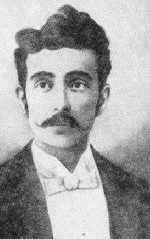Tomás Regalado (Salvadoran politician)
General Tomás Herculano de Jesús Regalado Romero (November 7, 1861 in Santa Ana, El Salvador – July 11, 1906 in Jutiapa, Guatemala) was President of El Salvador from 14 November 1898 until 1 March 1903. He was a military ruler and gained power by deposing Rafael Antonio Gutiérrez, a man he had previously helped achieve control of the country by taking part in a conspiracy to oust Carlos Ezeta four years earlier. Elected to a four-year term in 1899, he promoted the construction of railways, declared an amnesty for political exiles, and began the construction of the beautiful Santa Ana Theater.
Tomás Regalado | |
|---|---|
 | |
| 20th President of El Salvador | |
| In office 14 November 1898 – 1 March 1903 | |
| Vice President | Francisco Antonio Reyes |
| Preceded by | Rafael Antonio Gutiérrez |
| Succeeded by | Pedro José Escalón |
| Personal details | |
| Born | 7 November 1860 Santa Ana El Salvador |
| Died | 11 July 1906 (aged 45) Jutiapa Guatemala |
| Nationality | Salvadoran |
| Political party | Liberal |
| Spouse(s) | Concepción González Fortis |
| Signature | |
| Military service | |
| Allegiance | |
| Branch/service | Salvadoran Army |
| Rank | General |
| Battles/wars | Revolution of the 44 Totoposte Wars |
Upon leaving office, he remained active in the Army of El Salvador and was appointed Minister of War by his handpicked successor Pedro José Escalón. During a war against Guatemala in 1906 he led a Salvadoran invasion force and went into battle. Seriously wounded, he soon died on the 11th of June . His coup d'état led to the dissolution of the Greater Republic of Central America after his government withdrew from it.[1]
Regalado was the last in a series of presidents who had come to power by force during the 19th Century. His peaceful transfer of power to Pedro José Escalón in 1903 allowed for a degree of political stability that persisted until the events of 1931-32.
| Political offices | ||
|---|---|---|
| Preceded by Rafael Antonio Gutiérrez |
President of El Salvador 1898–1903 |
Succeeded by Pedro José Escalón |
References
- Walker, Thomas W. Nicaragua, the Land of Sandino. Boulder: Westview Press, 1981., p. 17.